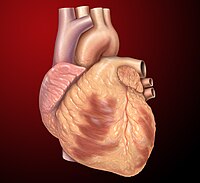
Photo from wikipedia
Anderson Fabry (AF) disease is a X-linked lysosomal storage disorder with multiorgan involvement. Cardiac disease, mainly represented by left ventricular hypertrophy (LVH) and arrhythmias, is the most frequent cause of… Click to show full abstract
Anderson Fabry (AF) disease is a X-linked lysosomal storage disorder with multiorgan involvement. Cardiac disease, mainly represented by left ventricular hypertrophy (LVH) and arrhythmias, is the most frequent cause of premature death. It is well know that specific therapy is less effective after the development of LVH and myocardial fibrosis, therefore early cardiac detection (before LVH) is important. New cardiac magnetic resonance (CMR) parametric imaging techniques (T1 and T2 maps) enable myocardial tissue changes associated with AF disease. To evaluate the relationship between CMR tissue characterization and clinical and instrumental manifestations of AF disease to find early markers of cardiac involvement. 31 AF patients (9 males, mean age 49±16 years) underwent ECG, echocardiogram and contrast CMR. TnI, BNP, pro-BNP and serum lyso-Gb3 were dosed. T1 mapping was performed in a pre-contrast acquisition with the modified Look-Locker inversion recovery (MOLLI) sequences. CMR results were compared with those of 43 healthy age and gender-matched controls. In AF patients native septal T1 values were significantly lower compared to healthy controls (median 949 vs 991 msec, p=0.0137) and were inversely related to Lyso-Gb3 serum levels (p=0.003). Patients with LVH had lower T1 septal values in comparison with patients without LVH (892 vs 981 msec; p=0.0012). Patients with classic form had abnormal low T1 values more frequently than pts with late onset variant (78 vs 23%; p=0.038). In AF patients native septal T2 values were significantly higher compared to the control group (53 vs 49 msec; p=0.0004) and correlated with troponin I (p=0.008) and NT-pro BNP (p=0.006) serum levels. No difference was found between pts with and without LVH (53.5 vs 52.5 ms; p=0.797) and the prevalence of abnormal high T2 values was similar between patients with late onset AF and pts with classical form (53% vs 50%; p=1.000). All patients with late onset AF and high T2 values were females. CMR T1 (low values) and T2 (high values) mapping are useful tools to detect early cardiac involvement before LVH and to better understand the pathophysiology of cardiac disease in AF patients. Subclinical tissue inflammation, detectable through T2 maps, seems to be an additional pathogenetic mechanism related to the Gb3 storage that contributes to organ damage and precedes LVH, particularly in females patients with late onset phenotype. Type of funding source: Public hospital(s). Main funding source(s): Sant'Orsola-Malpighi Hospital
Journal Title: European Heart Journal
Year Published: 2020
Link to full text (if available)
Share on Social Media: Sign Up to like & get
recommendations!